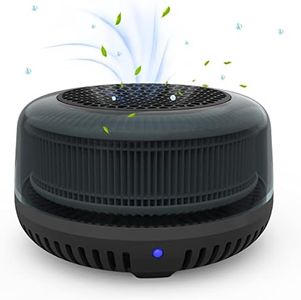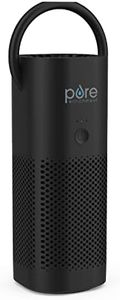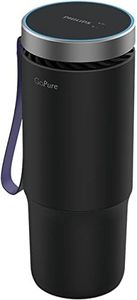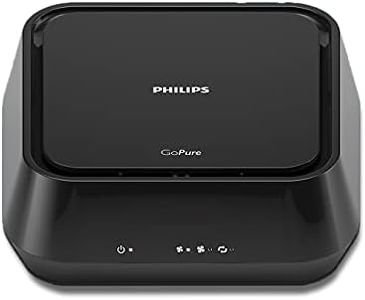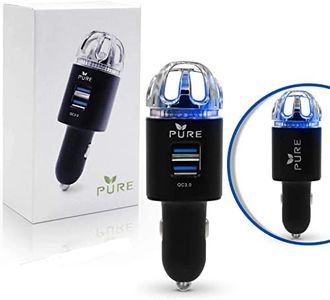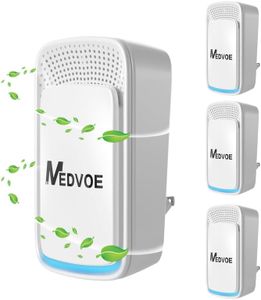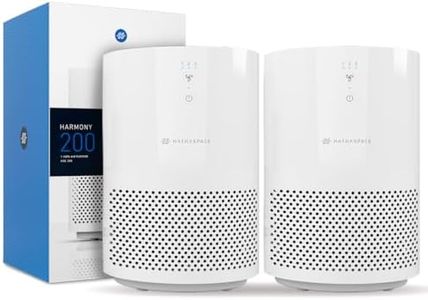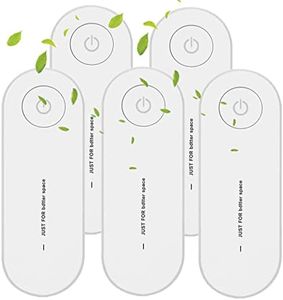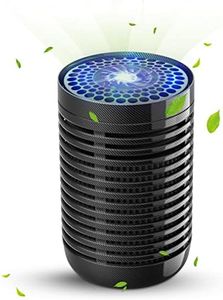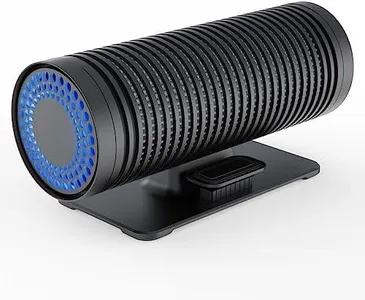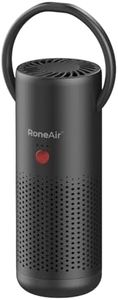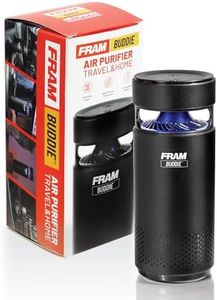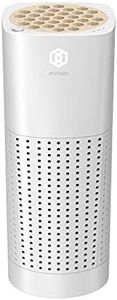9 Best Air Purifiers For Cars 2025 in the United States
Our technology thoroughly searches through the online shopping world, reviewing hundreds of sites. We then process and analyze this information, updating in real-time to bring you the latest top-rated products. This way, you always get the best and most current options available.

Our Top Picks
Winner
Pure Enrichment PureZone Mini Portable Air Purifier - Cordless True HEPA Filter Cleans Air & Eliminates 99.97% of Dust, Odors, & Allergens Close to You - Cars, School, & Office (Black)
Most important from
1179 reviews
The Pure Enrichment PureZone Mini Portable Air Purifier is designed with convenience and portability in mind, making it a solid choice for anyone looking to improve air quality in their car, office, or while traveling. Its True HEPA filter effectively captures 99.97% of airborne pollutants, including dust, allergens, and odors, which is excellent for people with allergies or respiratory issues. The two-stage filtration system, combining an Activated Carbon Pre-Filter with the True HEPA filter, addresses both smells and particulates, ensuring cleaner air around you.
One of the standout features is its cordless design, powered by a rechargeable lithium-ion battery that lasts up to 12 hours. Weighing less than a pound, this air purifier is easily portable, making it convenient for on-the-go use. The adjustable handle and three fan speeds add to its versatility, allowing you to customize your air purification experience.
The coverage area of 6ft² means it works best in smaller spaces, so it may not be effective if you're looking to purify larger areas or multiple passengers in a car simultaneously. Maintenance is generally manageable, but users will need to replace the filter periodically to maintain effectiveness. Lastly, while the 5-year warranty offers peace of mind, potential users should consider the cost of replacement filters in their overall budget.
Most important from
1179 reviews
Air Purifier with H13 True HEPA Filter: Portable Air Purifier for Exhaust Fumes, VOC, Smoke, Odors, Bacteria - 99.9% Removal to 0.1 Microns - For Car Travel, Bedroom (Black)
Most important from
359 reviews
The LUFTRUM Car Air Purifier is designed to enhance air quality in vehicles, making it a solid choice for those concerned about exhaust fumes, odors, and harmful particles. Its standout feature is the H13 True HEPA filter, which effectively removes up to 99.9% of contaminants down to 0.1 microns. This makes it particularly beneficial for individuals sensitive to air quality or those who frequently travel in polluted areas. The four-stage filtration system, including a high-efficiency fan, ensures that air is purified quickly, with the ability to filter the air in your car multiple times an hour.
Portability is another strong point; weighing under a pound and featuring a long power cord, it’s easy to install and relocate within your vehicle. The design is sleek and modern, appealing to those who value aesthetics alongside functionality. Additionally, it operates quietly, which is a major plus for driving without distractions. The automatic on/off feature with the car ignition adds convenience, while the built-in PM2.5 sensors provide real-time air quality feedback, giving users more control and awareness.
There are some drawbacks to consider. While the purifier has a low noise level, the higher fan speeds might still produce noticeable sound for some users. Although it purifies air effectively, it may not cover larger vehicles efficiently, so those with spacious vans or trucks should keep that in mind. Moreover, while the product is touted as energy-efficient, the need for a constant power source limits its use to vehicles equipped with functioning electrical systems.
Most important from
359 reviews
Philips GoPure GP5611 Small Portable HEPA Air Purifier with LED UVC Purification, for Car, Truck, RV/Camper, Reducing Allergens, Bad Smells, Smoke, Pet Odors, Bacteria, Viruses,Black
Most important from
251 reviews
The Philips GoPure GP5611 is a compact and portable air purifier designed for cars, providing effective air filtration while on the go. One of its standout features is the ability to eliminate up to 99.9% of viruses and bacteria using UV-C LED technology, which is safer than traditional mercury lamps since it doesn’t emit harmful ozone. The HESAMax cartridge also effectively captures a wide range of pollutants, including ultra-fine particles, allergens, and unpleasant odors, making it beneficial for those sensitive to air quality. Its easy installation in a vehicle's cup holder and automatic operation that syncs with your ignition offer added convenience.
On the downside, the noise level at 59 dB is relatively noticeable, which may be bothersome in quiet environments. While it is EPA and CARB certified, some users might expect higher purification capacity, especially in larger vehicles or during heavy pollution. The design is stylish and compact, but at 1.3 pounds, it's slightly heavier than some competitors, which could impact portability if you're looking for something ultra-lightweight. Additionally, the price point might be a consideration for budget-conscious buyers looking for more economical options.
The Philips GoPure GP5611 is particularly well-suited for car enthusiasts who prioritize air quality and health, especially for those with allergies or respiratory issues. Just keep in mind the noise level and weight when making your decision.
Most important from
251 reviews
Buying Guide for the Best Air Purifiers For Cars
Choosing the right air purifier for your car can significantly improve the air quality inside your vehicle, making your drives more pleasant and healthier. When selecting an air purifier, it's important to consider several key specifications to ensure you get the best fit for your needs. Here are the main factors to consider and how to navigate them.FAQ
Most Popular Categories Right Now
